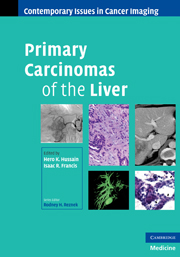Book contents
- Frontmatter
- Contents
- Contributors
- Series foreword
- Preface to Primary Carcinomas of the Liver
- 1 Epidemiology of hepatocellular carcinoma and cholangiocarcinoma
- 2 Surveillance and screening for hepatocellular carcinoma
- 3 Pathology of hepatocellular carcinoma, cholangiocarcinoma, and combined hepatocellular-cholangiocarcinoma
- 4 Radiological diagnosis of hepatocellular carcinoma
- 5 Staging of hepatocellular carcinoma
- 6 Surgical treatment of hepatocellular carcinoma: resection and transplantation
- 7 Non-surgical treatment of hepatocellular carcinoma
- 8 Radiological identification of residual and recurrent hepatocellular carcinoma
- 9 Radiological diagnosis of cholangiocarcinoma
- 10 Staging of cholangiocarcinoma
- 11 Treatment of cholangiocarcinoma
- 12 Uncommon hepatic tumors
- Index
- Color plates
- References
4 - Radiological diagnosis of hepatocellular carcinoma
Published online by Cambridge University Press: 04 August 2010
- Frontmatter
- Contents
- Contributors
- Series foreword
- Preface to Primary Carcinomas of the Liver
- 1 Epidemiology of hepatocellular carcinoma and cholangiocarcinoma
- 2 Surveillance and screening for hepatocellular carcinoma
- 3 Pathology of hepatocellular carcinoma, cholangiocarcinoma, and combined hepatocellular-cholangiocarcinoma
- 4 Radiological diagnosis of hepatocellular carcinoma
- 5 Staging of hepatocellular carcinoma
- 6 Surgical treatment of hepatocellular carcinoma: resection and transplantation
- 7 Non-surgical treatment of hepatocellular carcinoma
- 8 Radiological identification of residual and recurrent hepatocellular carcinoma
- 9 Radiological diagnosis of cholangiocarcinoma
- 10 Staging of cholangiocarcinoma
- 11 Treatment of cholangiocarcinoma
- 12 Uncommon hepatic tumors
- Index
- Color plates
- References
Summary
Contrast-enhanced computed tomography (CT) and magnetic resonance imaging (MRI) perform the major roles in the diagnosis of hepatocellular carcinoma (HCC) alongside alpha-fetoprotein (AFP) serology and biopsy. There is also increasing use of contrast-enhanced ultrasound (CEUS) for the diagnosis of HCC. Accessibility to each modality and expertise determine which is used as the major imaging tool for the diagnosis of HCC. In the context of the rapid increase in the incidence of HCC, it is important to recognize that there will be increasing reliance on imaging tools to diagnose and stage tumors.
Two sets of clinical practice guidelines published in the western literature form the basis of radiologic diagnosis of HCC in both Europe and the United States. These are the European Association for the Study of the Liver (EASL) guidelines formed at the single-topic conference on HCC in 2000 and the American Association for the Study of Liver Diseases (AASLD) practice guideline published in 2005.
Ultrasound
The role of ultrasound is primarily in the surveillance of at-risk patients. The introduction of contrast agents has presented new opportunities for ultrasound specialists in the diagnosis of HCC. HCC shows strong intratumoral enhancement in the arterial phase followed by rapid washout with an isoechoic or hypoechoic appearance in the portal and delayed phases (Figure 4.1). Regenerative and dysplastic nodules do not show early contrast enhancement. Selective arterial enhancement has been shown in 91–96% of lesions confirming a high sensitivity in identifying the arterial neoangiogenesis of HCC.
- Type
- Chapter
- Information
- Primary Carcinomas of the Liver , pp. 33 - 50Publisher: Cambridge University PressPrint publication year: 2009



